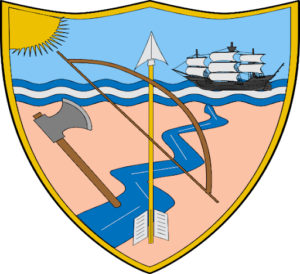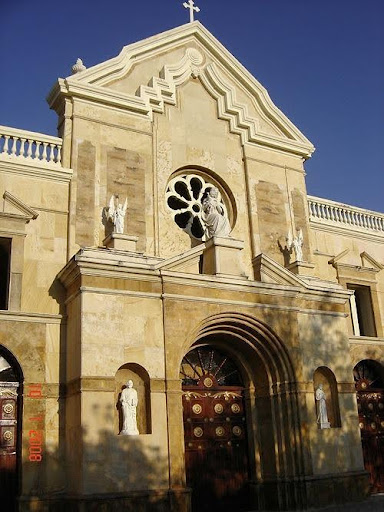Riohacha
Department




played a pivotal role, hosting many ships that supported the Colombian and Venezuelan independence causes. Notably, Admiral José Prudencio Padilla, a native of Riohacha, emerged as a significant figure in the independence struggles of both nations. Riohacha achieved municipality status in 1954 and was later designated the capital of the newly formed La Guajira Department in 1964.
The Almirante Padilla Plaza in downtown Riohacha.
Geography of the city
Riohacha, situated on Colombia’s northern coastline, serves as the capital of the La Guajira Department. The city holds a strategic position, gazing out over the Caribbean Sea while also acting as a threshold to the vast stretches of the La Guajira Desert, one of South America’s unique desert regions. This dual identity, both coastal and desert, has sculpted Riohacha’s character, offering both sandy beaches and arid landscapes. The city’s terrain is mainly flat, making urban development and agriculture prevalent activities. Although located near the equator, its desert adjacency gives it a distinctively drier and warmer climate than typical Caribbean cities. Even within this dry setting, biodiversity thrives, as seen in sanctuaries like Los Flamencos, a refuge for flamingos and myriad bird species. Geographically, Riohacha is nestled by the Ranchería River, which emerges from the Sierra Nevada de Santa Marta mountains and serves as a pivotal waterway for the region. In terms of geospatial location, it stands at approximately 11.5444° N latitude and 72.9072° W longitude. Riohacha’s position also makes it a key hub in northern Colombia, with cities like Santa Marta located about 165 kilometers to the southwest, providing a reference point for its relative location.ence.

Population
268 758 (2023)
188,014 (2018)
One photo representative of the city
The Malecón de Riohacha stands as a testament to the rich blend of natural beauty, indigenous culture, and modern-day vibrancy that Riohacha, a picturesque city on Colombia’s Caribbean coast, has to offer. Stretching gracefully along the coastline, this promenade is an epitome of the city’s soul, drawing locals and tourists alike to its captivating allure.
At the heart of the Malecón is a display of the deeply-rooted Wayuu culture, the indigenous people of the Guajira Peninsula. As you stroll along the Malecón, you’re immediately greeted by the kaleidoscope of colors from the traditional mochilas, handwoven bags that have become symbolic of Wayuu craftsmanship. These bags, with intricate designs representing natural elements and Wayuu mythology, are more than just items for sale. They are narratives of a proud culture, tales woven into threads, telling stories of heritage and tradition.
The Malecón is not just a cultural hub; it’s also a gastronomic paradise. As daylight wanes and the Caribbean sun casts a golden hue over the horizon, the promenade comes alive with the sizzle and aroma of street food stalls. Freshly caught seafood, ranging from fish to shrimp and lobster, is grilled to perfection and served with local delicacies. The tantalizing scent wafting through the air is an irresistible call to partake in the city’s culinary offerings.
Moreover, the Malecón serves as a tranquil escape. The gentle lapping of the Caribbean waves, coupled with the soft melodies of vallenato, a popular folk music of the region, creates an ambiance of serenity. Here, amidst the buzz of the city, one finds a place of reflection, of connection with nature, and of immersion in the diverse tapestry of Riohacha’s life.
In essence, the Malecón de Riohacha is more than just a scenic walkway by the sea. It’s a journey through time, culture, and flavors, making it an indispensable part of the Riohacha experience.

Etymology
The name “Riohacha” dates back to the era of Spanish conquest and colonization in La Guajira between 1526 and 1536. Its origin story is shrouded in three prominent tales, all connected to the exploration around the river’s mouth in the central part of the La Guajira Peninsula. One story narrates how a local indigenous youth led a lost and dehydrated Spanish troop to the river. In gratitude, the captain gifted him an axe and named the spot “El Río de La Hacha.” Another tale tells of a Spanish captain who dropped his cherished axe in the river and named the river “Río de La Hacha” in memory of the lost tool. The third narrative chronicles a group of European explorers who stumbled upon an elegantly crafted axe on the river’s shore, presuming they were the area’s first visitors. Thus, they named the river “Río de la Hacha.”
In the Wayuunaiki language, “Süchiimma” translates to “Land of the River,” with “Süchii” meaning river and “Mma” denoting land. The city bears other titles such as “Portal de Perlas” (referring to its pearl-rich history), “Capital of the Magical Arreboles” (celebrating its breathtaking Caribbean sunsets), and “Mestiza del Nordeste” (highlighting its diverse culture and the Trade Winds from the Northeast).
What the city is known or famous for
The Cathedral of Our Lady of Remedies, often referred to as the Riohacha Cathedral, stands as a testament to the Catholic Church’s devotion to the Virgin of the Remedies. Serving as the central hub for the Roman Catholic Diocese of Riohacha, it also functions as the residence for the residing Bishop.
This colonial-era edifice is situated at 7-13 on Second Street in Riohacha, within Colombia’s La Guajira department at the country’s northernmost point. The construction of the cathedral spanned from 1835 to 1852. In 1906, the façade underwent significant reconstruction to both prevent the walls from collapsing and to impart a more distinct artistic flair. Adjacent to the primary altar, four marble altars were installed, and a dome was erected overhead.

